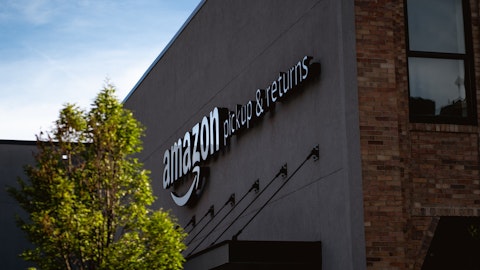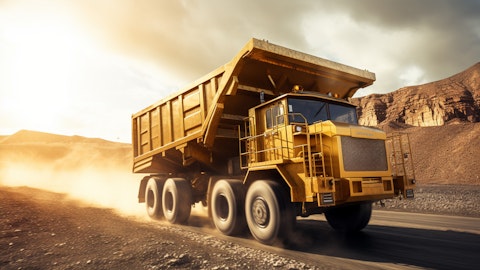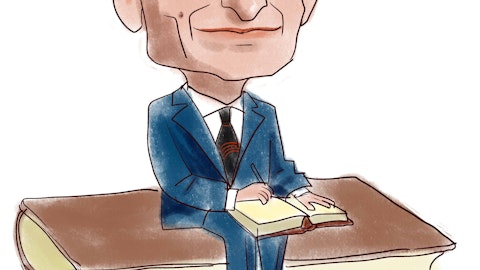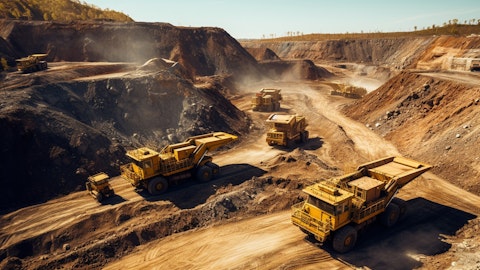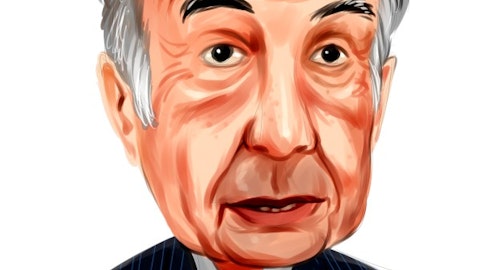Freeport-McMoRan Inc. (NYSE:FCX) Q3 2023 Earnings Call Transcript October 19, 2023
Freeport-McMoRan Inc. beats earnings expectations. Reported EPS is $0.39, expectations were $0.32.
Operator: Ladies and gentlemen, thank you for standing by. Welcome to the Freeport-McMoRan Third Quarter Conference Call. At this time, all participants are in a listen-only mode. Later we will conduct a question-and-answer session. [Operator Instructions] I would now like to turn the conference over to Ms. Kathleen Quirk, President. Please go ahead, ma’am.
Kathleen Quirk: Thank you and good morning. Welcome to our conference call. Earlier this morning, FCX reported our third quarter 2023 operating and financial results. And a copy of the press release and slides are available on our website at fcx.com. Our call today is being broadcast live on the Internet, and anyone may listen to the call by accessing our website homepage and clicking on the webcast link for the conference call. In addition to analysts and investors, the financial press has been invited to listen to today’s call, and a replay of the webcast will be available on our website later today. Before we begin our comments, we’d like to remind everyone that today’s press release and certain of our comments on the call include forward-looking statements, and actual results may differ materially.

A mining truck loaded with precious metals in an open pit mine. Editorial photo for a financial news article. 8k. –ar 16:9
I’d like to refer everyone to the cautionary language included in our press release and presentation materials and to the risk factors described in our SEC filings. On the call with me today are Richard Adkerson, our Chairman of the Board and CEO; Maree Robertson, our Chief Financial Officer; Mark Johnson, Chief Operating Officer for Indonesia operations; Josh Olmsted, Chief Operating Officer for the Americas, Mike Kendrick, who heads our molybdenum business; Cory Stevens, who leads our technical services and engineering and construction group; and Steve Higgins, our Chief Administrative Officer. We are going to start with Richard. He’ll make some opening comments, and then we’ll be reviewing the slide materials, and then we’ll open the call for your questions.
Go ahead, Richard.
Richard Adkerson: Good morning. Yes, good morning. Thanks, Kathleen. As Kathleen said, she’s going to review our operations and financial results for the third quarter. Big picture, we had very strong operations performance and this was really notable in face of a number of challenges we faced at different locations around the world. Once again, Team Freeport answered the bell and rang through. Stating the obvious is a complicated geopolitical and macroeconomic world. Freeport family around the world is sad for the poor people in Israel, in Gaza, and in the Ukraine and praying for a resolution to those conflicts. Macroeconomic factors with higher interest rates are negative for the price of copper and Freeport’s equity. It goes without saying our business by design, by strategy, is correlated to the price of copper in response to the recent lower copper prices.
We are supported by having a strong balance sheet, which we’re committed to maintaining, and by having the ability to manage our capital cost and operations to be responsive to the price environment. We remain very confident about the long-term outlook for copper and for our company’s equity. The current situation does nothing but bolster the longer-term outlook for copper prices as a commodity and for our future returns to Freeport shareholders. We look forward to answering your questions and I’ll turn the call over to Kathleen to review our results.
Kathleen Quirk: Thank you, Richard, and I’m going to start on slide three where we summarize our key operating and financial highlights for the third quarter. We delivered another quarter of strong execution, production results across the portfolio were solid, totaling £1.1 billion of copper and over 500,000 ounces of gold during the quarter. Our copper sales were 8% above our estimates going into the quarter, and despite strong gold production, our third quarter gold shipments were slightly below previous estimates. That reflected timing associated with some administrative approvals in Indonesia, but this is expected to turn and set up for higher gold sales in the fourth quarter. Our unit net cash costs on a consolidated basis averaged $1.73 per pound in the third quarter that was similar to the year ago quarter.
The increase compared to our guidance of $1.61 per pound largely reflects the impact of export duties in Indonesia, which we continue to review and discuss with the Indonesian government. With average copper prices of $3.80 per pound in the quarter, we generated EBITDA of $2.2 billion. Our operating cash flows, which were net of $500 million in working capital uses, totaled $1.2 billion, and those exceeded our mining capital expenditures, totaling $800 million, which exclude capital associated with our smelter project, totaling $400 million in the quarter, and that’s being funded from proceeds that we raised last year in a financing transaction. We’re making steady progress on the smelter projects in Indonesia. The construction project on the new greenfield smelter is 84% complete, and we’re on track to begin ramping up during 2024.
Richard talked about our balance sheet, our balance sheet, liquidity, financial flexibility remain in great shape, excluding the net debt associated with the smelter projects in Indonesia. We ended the quarter with $800 million in net debt. As we approach the end of 2023, our team remains focused on continuing strong and safe execution of our operating plans. And we expect to have another quarter of strong production results. And we’re going to continue to advance several important initiatives to drive long-term value in our business. Moving to the next slide, slide four, we talk about copper markets. And as Richard mentioned, the long-term fundamental outlook for copper remains compelling, characterized by rising demand associated with global investments in electrification and limited supplies.
In the short term, copper prices have been impacted by macro sentiment tied to rising interest rates, U.S. dollar strength, and sentiment on the global economy. Copper inventories on exchanges have risen in recent weeks, and that follows a multi-year period of declines. When we look at the overall inventories on the exchanges, they remain low by historical standards and in relation to the growing size of the market. The reality on the ground, when we look at the macro sentiment, we also need to look at the reality on the ground. And the new structural demand drivers for copper are mitigating traditional cyclical uses. In the U.S., several of our customers are reporting growth in power cable and building wire for utilities and data centers and rising demand from the automotive sector.
There are pockets of weakness tied to residential housing, but this is being offset in other sectors. China’s consumption continues to grow despite the country’s weak property sector, supported by massive investments in wind and solar and growth in electric vehicle production. And there are recent signs we’re seeing that economic activity is picking up in China. We’re also seeing growth in copper consumption in India, which has historically used less copper per capita than other countries. We can’t predict short-term macro forces that have heavily influenced the market, but our conviction for the long-term fundamental outlook remains strong. Copper is the metal when it comes to electrification and Freeport’s well-positioned as a leader in the global copper industry.
When we look at the long-term, we’re looking at the next several years where demand is expected to accelerate with third-party projections for demand to double by 2035. At the same time, the ability of the copper industry to meet this rising demand is a major challenge. The recent weakness in price combined with higher capital costs to develop new mines are making it more difficult to justify new project development, which is essential to the future. With this backdrop, we believe the current price is not sustainable and prices will need to rise to incentivize new supplies. At Freeport, we benefit from a large reserve position and an even larger resource position to grow our business in the future. We’re going to take a long-term view and also be mindful of the short-term pressures on the market.
Moving to the next slide, on slide five, we want to highlight some of the key operational drivers for our business during the quarter. In the U.S., our leach innovation initiative where we’re deploying new operating practices to traditional leaching is showing tangible progress. Incremental copper from these incentives totaled 46 million pounds in the third quarter. This is 90% of our initial targeted run rate of 200 million pounds of copper per annum. We see ongoing opportunities for additional scale as we aggressively advance this highly valuable initiative. Additionally, we’re continuing to focus on enhancing productivity in our U.S. mining and milling operations. We know there’s opportunity here to improve and it’s a key focus area for us.
At Cerro Verde in Peru, where we operate one of the largest concentrate sites in the world, the mill averaged over 430,000 tons per day during the quarter. That was a new quarterly record. You will recall this is a site that was designed at 360,000 tons per day. Overtime, our team has found ways to improve efficiencies there. We are really proud of the Cerro Verde team. At Grasberg, our mill rates averaged 207,000 tons per day for the quarter, processing high grades of copper and gold ore. The production for the quarter exceeded 400 million pounds of copper and over 500,000 ounces of gold that was in a single quarter, demonstrating the size and scale of this operation. We had several days of the mill throughput in excess of 220,000 tons per day.
And a highlight of the quarter was the performance of Grasberg Block Cave. We mined from that ore body over 130,000 tons per day, on average. We installed a new gyratory crusher at the Grasberg Block Cave, which gives us the ability to process more material from that large ore body. And we recently reached new records of over 160,000 tons a day. We’re working to complete the new SAG mill at Grasberg. We’re expected to complete construction by the end of the year. And that’ll give us more opportunities in the future to ramp up our mill rate even further. Turning to slide six, we talk about our growth initiatives. And as we look at this situation where we have growing demand for copper over the next several years, and the limitations and the high capital intensity and risk for greenfield projects, our strategy is really focused on development of extensions of our existing operations and our portfolio of brownfield opportunity.
We characterize our growth in near-term, medium-term, and longer-term development options. On the near-term side, the initial target of 200 million pounds per year of copper from our leach initiative has essentially been met. And now we’re focusing on sustaining it and scaling it further. On prior calls, we discussed our initiatives to retain more heat in the stockpiles. And those activities are continuing. A big driver of the success in the last several months has been on our Leach Everywhere work, where we’re applying solution to areas of the stockpile which have not previously been leached. We’re also conducting targeted drilling to inject solution to areas within the stockpile where solution may have been blocked over time. And our data and modeling can now provide information that targets specific areas of opportunity.
And we’re gearing up to do this more at scale. We now believe we can scale these activities and double the incremental copper to 400 million pounds per annum over time. This is just from applying our operating practices at a larger scale without relying on new technologies. We’re also continuing our work on the new technologies front. And that’s going to give us the opportunity with success to reach our ultimate goal of 800 million pounds per annum from this initiative over the next three to five years. Remind everybody we have 40 billion pounds of copper in our stockpiles that’s already been mined. This is not in our reserves. And it’s an opportunity for us to get recovery from this copper that previously was thought to be waste material. This initiative has the best economics of anything in our portfolio given its low capital intensity and low incremental operating costs.
And we’re pursuing it very aggressively. Our productivities in the U.S., which I mentioned earlier, are focused on rebuilding the experience of our workforce. We’ve had a large number of new hires in recent years. And we need to rebuild our skills and experience, enhancing our practices to achieve better equipment performance and reliability, and taking advantage of new technologies and automation to restore and improve on productivity metrics that weakened during the pandemic. By increasing our productivity in the U.S., we have the opportunity to add an additional 200 million pounds per year from our existing assets with limited capital investment. We’re also continuing our work on a potential expansion of the Baghdad mine in Northwest Arizona.
We’re completing a feasibility study. And we’re taking some steps now to enhance optionality for the future, including making some investments in autonomous haulage in our mining operations at Baghdad. And we’re advancing investments in our tailing infrastructure for the future. We are setting up Baghdad expansion project as an option for the future. The timing of it will depend on market conditions. We’re looking at the increased capital cost requirements for projects and consider that. We’re also looking at the availability of labor. And we’ll make all those reviews before finalizing our decision on the timing of this project. But it’s a very large resource for us. We’ve got significant reserves spanning over 80 years there and a good opportunity for expansion in the future at the right time.
We also have a major opportunity for expansion at El Abra mine in Chile. This is a very large resource that could support a concentrator on the size of the concentrator we added at Cerro Verde several years ago. We’re retesting the economics to update project capital costs in light of the recent capital cost experience of other large projects. And in parallel, we’re planning investments in water infrastructure to support the current operation and provide optionality for the future. Again, this is about options for expansion at the right time. And we’ve got the portfolio with a lot of option value within the Freeport portfolio. Our Kucing Liar development in Grasberg is proceeding on schedule. We expect to commence production by 2030. The huge ore body ramping up to 550 million pounds of copper and 560,000 ounces of gold in the next decade.
We’re also conducting some additional exploration in the Grasberg district where we have identified some potential below our deep MLZ [Ph] ore body. We’re continuing to advance discussions in Indonesia for extension beyond 2041. That would open the door for continuation of large scale mining and potential additional development options in one of the world’s largest and highest grade copper and gold mining districts. Longer-term, we’re focused on a major opportunity that we have in the U.S. at the Safford Lone Star District. We’ve identified a significant resource there. And we continue to see the Safford District with the potential to add another cornerstone asset of scale in the U.S. We’re in an outstanding position as we look at our large resource and reserve position and the experience of our team to continue our leadership role in supplying copper to a world with growing requirements.
We’re going to continue to be disciplined in our approach. And we’re going to be focused on executing projects so we can create value for shareholders. Slide seven provides our three year outlook for sales volumes. You’ll see this is largely unchanged from our prior forecast. We’ve increased our 2023 copper sales volumes by about 40 million pounds. And that reflects the updated shipping schedules expected in Indonesia. There’s no material changes in guidance for 2024 or 2025. We do believe we have some upside to these numbers with continued success in our leach efforts and our work on productivity enhancements in the U.S. We’re turning to our regional data on slide eight. We show our projected 2023 volumes and unit net cash costs by region.
The Americas, including North America and South America, comprise about 63% of our 2023 copper sales and all of our molybdenum sales. Indonesia represents 37% of our copper sales and all of our gold sales. The Americas volumes are similar to a prior forecast. And our sales estimates from Indonesia have been increased to reflect the shipping schedules that I mentioned earlier. On a consolidated basis, our unit net cash costs for the year are forecast at $1.63 per pound. It’s slightly above the prior forecast of $1.55, $0.07 of that relates to export duties, which remain under discussion with the Indonesian government. We’ve also incorporated some higher costs for energy compared with the prior forecast. And after moderating in the first half of the year, we’re seeing energy costs, particularly for diesel fuel, rising.
We’re continuing to work to enhance productivity to mitigate the cost increases we’ve experienced since 2022, really across the board for labor, our contract maintenance services, equipment component costs, and a series of input costs that have risen. And we’re working hard to try to mitigate those through effective cost management and productivity enhancements. Turning to cash flows on slide nine, we model our results for EBITDA and cash flow for 2024 and 2025 showing a price range of four to five dollar copper. We’ve got sensitivities on the page so you can use for looking at the changes based on changes in input costs or copper prices. The annual EBITDA would range under these scenarios from nearly ten billion dollars per annum at four dollar copper to fourteen billion dollars at five dollar copper and operating cash flows would range from seven to ten billion dollars under these assumptions.
With long live reserves and large scale production, we’re well positioned to benefit from future metals intensive growth and that will provide opportunities for organic investments and cash returns under our performance based payout framework. On slide 10, we show our current forecast for capital expenditures for 2023 and 2024. 3.2 billion total for 2023 is similar to our prior estimate and our capital for 2024 is 3.9 billion compared with the prior estimate of 3.8 billion. For 2024, we’ve added some discretionary capital to commence a new project in Indonesia to transition our energy source from coal to clean air LNG over the next three to four years and we expect to start that project next year. The discretionary projects total a little less than $2 billion over 2023 and 2024.
This category reflects the capital investments we’re making in new projects that under our financial policy are funded with the 50% of available cash that’s not distributed. We’ve got some details on those projects in the reference materials. Slide 11, we’ve included some updated pictures of the smelter project in Indonesia. This is a major undertaking. It’s being executed very efficiently. We’re making steady progress toward completion. For the Greenfield smelter, we’re now 84% complete on construction and we expect to begin commissioning the project by the middle of next year and ramping up to full production by the end of the year. We’re also nearing completion of an expansion project that we’re doing with our partner to expand the existing smelter in Indonesia.
We expect construction to be completed by the end of this year in 2023. We’re really pleased with the strong execution of our internal project team and our outside contractor to contain costs and meet schedules in a very complex environment for major project development. On slide 12, I just wanted to update you on some climate initiatives. We published an updated climate report during the third quarter, which is available on our website. But I mentioned in Indonesia we’re advancing plans to develop, to transition our coal to LNG. We have plans to develop a 265 megawatt gas-fired combined cycle facility and that would replace the coal units that were developed there over 25 years ago. The project has a cost of roughly $1 billion and the economics, as we looked at it, would eliminate the cost to refurbish and expand the existing coal units over time.
The incremental economic cost of this project is roughly $400 million. Importantly, the transition would reduce significantly PT-FI’s greenhouse gas emissions. And together with other initiatives PT-FI has undertaken, the total reduction would be on the order of 60% compared to the 2018 baseline. It’s a very exciting project for us looking forward. We’re also very pleased to report that we have a new power purchase agreement in Peru at Cerro Verde that will allow Cerro Verde the benefit of 100% of its power from renewable sources in 2026. And finally, on slide 13, we wanted to reiterate the financial policy priorities centered on a strong balance sheet, cash returns to shareholders, and investments in value-enhancing growth projects. The balance sheet is strong.
We’ve got strong credit metrics, significant flexibility within our debt targets to execute on our projects. At the same time, we’ve distributed over $3.5 billion to shareholders through dividends and share purchases, and we have an attractive future long-term portfolio that will enable us to continue to build long-term value for shareholders. We’ve got to continue to focus on the current situation, though, and we’re going to continue to monitor current market conditions. We’ll carefully manage the timing of our projects to ensure our financial flexibility remains strong. Our team is really experienced in navigating challenging conditions while maintaining a focus on pursuing long-term value in the business and executing our plans responsibly, safely, and efficiently.
That concludes our prepared remarks, and we appreciate all your attention and interest, and we’ll now take your questions.
See also 11 Best Technology Dividend Stocks To Buy and 10 Best Stocks That Pay Monthly Dividends.
Q&A Session
Follow Freeport-Mcmoran Inc (NYSE:FCX)
Follow Freeport-Mcmoran Inc (NYSE:FCX)
Operator: [Operator Instructions] The first question will come from the line of Alex Hacking with Citi. Please go ahead.
Alex Hacking: Yes, morning, Richard and Kathleen. I wanted to ask a couple of questions on U.S. operations. Could you maybe discuss the cost performance there? That seems like it’s a little bit higher than guidance and how you see that going forward. And then secondly, just on production, just so I understand, production this is about 340 million pounds. Does that include the incremental 46 million pounds from the new leaching? Is that all in the U.S.? And I guess if so, that sort of implies that production without those pounds would be below 300 versus like 370 million last year. So, maybe just some comments around that and how you see the leaching, impacting the production profile there going forward. Thanks.
Kathleen Quirk: Thanks, Alex. I mean, your question is right in terms of the performance in the U.S. of the base business. We’re continuing to experience some challenges on productivity. We’ve got, we’ve been hiring people. We’ve got a lot of new people in our workforce. And so we’re very focused on improving the productivity in the U.S. We’re focused on maintenance. We’ve had some challenges with premature failures and some maintenance challenges that we’re getting caught up on. We’ve also had a lot of increased costs related to component parts. We’ve had some increases in the cost of labor, particularly contract labor. You’ve probably seen all the activity in Arizona outside of copper with a lot of investment in various industries.
It’s a very competitive market. So the cost rises in North America have been higher than what we’ve experienced elsewhere. Of course, we’ve also had the benefit in international locations of the stronger dollar, which offset some of the labor cost impact. So you see that more in the U.S. But you’re right that without the leach pounds, the incremental leach pounds that we accomplished year-to-date, we would have had lower production. And what we need to do is really get both of those flywheels going at the same time because the more we place, and we’ve been missing some of our placements in terms of the mining rates and the placements on the leach piles, the more opportunity we have to get more out of it through these leach initiatives. So it’s a big focus of Josh and our whole team to really work on getting productivity up.
If you look at grades, we’re in a period right now at Morenci where we’ve got low grades. And the hallmark of Freeport has been to manage costs very well, given the low grades we have. But we’ve got to work our way through that and get our flywheel moving again to get productivity up. In terms of the leach pounds and the impact on cost, what really needs to happen with the leach project to really start seeing the impact on unit cost is enough confidence to be able to increase our reserves? And that will allow us to essentially, in the financial results, see lower unit costs as we add reserves and we’re spreading costs over a larger number of pounds that economy of scale will start to come through. So the more confidence we get in this, the more we’re able to actually put these opportunities into reserves and have enough confidence to do that, that’s when you’ll start to see the impact on the net unit cash costs.
But I don’t know if that was a long answer, but did that answer your question?
Alex Hacking: Yes, that was a great answer, Kathleen. I really appreciate all the color. Thanks so much and good luck with everything.
Kathleen Quirk: Thanks, Alex.
Operator: Your next question comes from the line of Chris LaFemina with Jefferies. Please go ahead.
Christopher LaFemina: Hi, Richard. Hi Kathleen. Thanks for taking my question. I just wanted to ask about El Abra, which has tremendous potential. You’ve talked about it for a long time. You could build a big mill project there. With the clarity now around Chilean mining taxes, I would assume that’s helpful. And also, I’m not sure if you’ve looked into the recent double taxation treaty, which I think for U.S. companies makes Chile potentially a more attractive investment. So wondering first kind of how you’re thinking about that now and what we can sort of expect if you do progress in this project in terms of timing, capital cost scale, and then maybe as importantly, your partner’s ability to help fund whatever you develop there, because I assume it’s going to be a capital intensive project.
I’m not sure Codelco has the capital to contribute alongside you with this. So how should we think about that? And again, does that double taxation treaty between Chile and the U.S. affect the economics of this project to potentially drive an investment decision? Thank you.
Kathleen Quirk: Thanks, Chris. Both of those items that you mentioned, the recent clarity around taxation in Chile and the issue between the treaty between the U.S. and Chile are both helpful. Quite frankly, if that hadn’t been resolved, the latter had not been resolved, that would have posed a big challenge for us in developing the project. But that’s been resolved. And so now we’re really turning to the economic side of the equation. And we’ve been watching what’s been going on in Chile with other major projects. We did a lot of work on this project, on the El Abra project, and it has good economics, but we want to retest those economics with current capital costs. And that’ll be something that we’ve already started working on, but that’s something we really want to get our heads around is, does it make sense?
What’s the timing given rising capital costs? I mean, you’ve seen really significant cost blowouts in Chile in recent time. And we want to make sure that we can deploy capital effectively, efficiently in this market. And as Richard was talking about, the copper price today doesn’t really support new investment. And so, of significance. And so our focus really has been in this kind of environment on what we can do to be less capital intensive while continuing to advance our options and create optionality in the portfolio. Our plans in Chile currently are to invest in some water infrastructure, desalinization project that would allow us to extend the life of the current operation, and then that would give us optionality for the bigger expansion.
